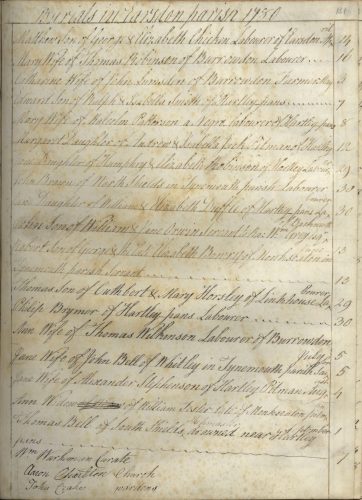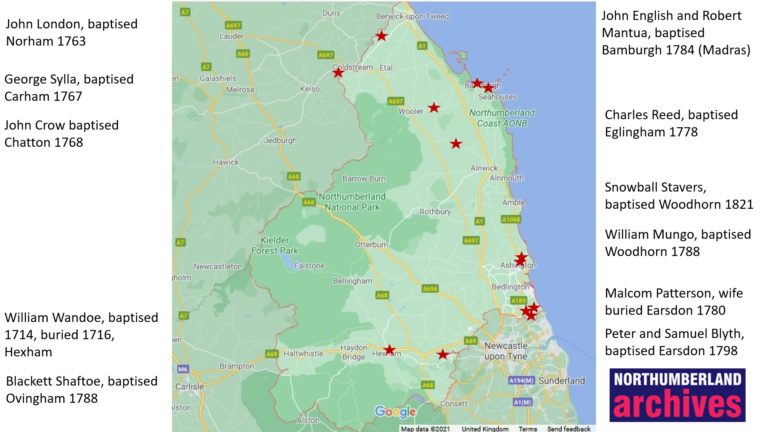Burial of Mary Patterson in Earsdon, 1780
Reference: EP 6/4A
Suggested age groups: KS2, KS3, KS4, Lifelong Learners
Subject areas: Black Presence, Industrialisation, Historical Sources
CONTEXT
Henry VIII ordered that parish registers of baptisms, marriages and burials be kept from 1538. Very few have survived from this date. Elizabeth I repeated her father’s order in 1558 and then ordered that parish registers be kept on parchment (rather than more vulnerable paper) in 1597. More registers survive from this date.
Parish registers are the most used sources at county archives. They are often used to trace researchers’ family history, but also contain information that can be useful to different types of researchers.
Most of the people of African descent living in this country during the eighteenth-century were men. Some historians* suggest that 80% of the Black population would have been male. This reflects the ratio of men to women forcibly transported from Africa to the West Indies and America.
Most of the men and women of African descent living in Britain at this time worked as servants. It is not always clear whether their official legal status was free or enslaved.
Eighteenth-century British newspapers contained advertisements for men, women and children who had run away from their enslavers. The adverts offer rewards for the return of the owners’ “property”. Many of these men and women are referred to as servants.
*See David Olusoga “Black and British: A Forgotten History”, London 2016. His discussion of the work of Felicity Nussbaum a scholar of the eighteen-century.
Malcolm Patterson is mentioned in this parish register entry as the husband of Mary Patterson who was buried on 8 May 1780. Malcolm is described as a labourer. This is the only incidence that we have of a man of African descent who was not working as a servant in Northumberland at this time. It is also the only evidence of a married man.
It is very likely that Mary was white. As there were very few women of African descent in Britain at the time (see above), Black men tended to marry and have families with white women.
Hartley Pans is now known as Seaton Sluice. From the Middle Ages until the late eighteenth-century there were salt pans in the area. Sea water was evaporated in the pans and the salt that remained dug up to be sold. Malcolm may have worked in the production of salt. It is also possible that he was attracted to Seaton Sluice by its industrial boom. The Delaval family sunk mines, expanded the natural harbour and built a glass bottle works in the village during the eighteenth-century.
Documents from the eighteenth-century regularly use language that is unacceptable. People of African descent were often called “negroes” as in this parish register.
ACTIVITIES
ACTIVITY 1
Background
Malcolm Patterson is mentioned in this parish register entry as the husband of Mary Patterson who was buried on 8 May 1780. Malcolm is described as a labourer. This is the only incidence that we have of a man of African descent who was not working as a servant in Northumberland at this time. It is also the only evidence of a married man.
It is very likely that Mary was white. As there were very few women of African descent in Britain at the time (see above), Black men tended to marry and have families with white women.
SEE
See: When was Mary Patterson buried?
See: Who was Malcolm Patterson?
See: What was Malcolm’s job?
See: What colour was Malcolm?
See: What colour was Mary likely to have been?
See: Where is it possible that Malcolm may have worked?
THINK
Think: Why do you think Black men tended to marry and start families with white women?
Think: It is very likely that, if they had a family, Malcolm and Mary’s children would have been mixed race. How do you think mixed race people were treated during the eighteenth-century?
Think: Are there prejudices against mixed race people today?
Think: Are there prejudices against inter-racial couples today?
Think: Why do you think Malcolm is the only recorded instance of a man of African descent not working as a servant in Northumberland?
Think: Why do Why do you think Malcolm is the only recorded instance of a man of African descent being married in Northumberland?
Think: Do you think there could have been other Black men in Northumberland in similar positions to Malcolm? Could this evidence have been lost or nor recorded?
DO
Do: Start by looking at the document before reading the context. List the facts that the document tells you about Mary and Malcolm Patterson.
Do: Using your list of facts, write a list of assumptions that you could make about Mary and Malcolm based on the evidence.
Do: From your lists, as a historian what can you learn about Black presence in Northumberland at this time?
Do: Compare what you have learned from this document to other evidence of Black presence in Britain at this time. How is Malcolm’s life similar or different to others?
Do: What would your next steps be as a historian to find out more about Malcolm and Mary, or other people of African descent in Northumberland at this time?
Do: Discuss attitudes towards inter-racial relationships during the eighteenth-century. How do they differ from attitudes today?
Do: Discuss attitudes towards inter-racial relationships today. Are there still prejudices?
Resources
ACTIVITY 2
Background
Most of the people of African descent living in this country during the eighteenth-century were men. Some historians* suggest that 80% of the Black population would have been male. This reflects the ratio of men to women forcibly transported from Africa to the West Indies and America.
Most of the men and women of African descent living in Britain at this time worked as servants. It is not always clear whether their official legal status was free or enslaved.
Eighteenth-century British newspapers contained advertisements for men, women and children who had run away from their enslavers. The adverts offer rewards for the return of the owners’ “property”. Many of these men and women are referred to as servants.
SEE
See: Which gender were most people of African descent living in Britain during the eighteenth-century?
See: What percentage of the Black population in Britain would have been male in the eighteenth-century?
See: What did most of the people of African descent living in Britain during this time work as?
See: What word is used to describe Malcolm’s colour in the record?
THINK
Think: Why do you think there was a much larger number of men of African descent living in Britain than women?
Think: What can you infer from this statistic about the ratio of men and women forcibly transported from Africa?
Think: Why do you think more men were forcibly transported from Africa than women?
Think: Does the word servant imply someone is free or enslaved?
Think: Why do you think people in Britain ran away from their enslavers?
Think: What are the connotations of the word “servant”?
Think: What are the connotations of the word “property”?
Think: Do you think Malcolm was free from birth or an enslaved person who ran away?
Think: What does Malcolm’s name imply?
DO
Do: Discuss whether the terms “servant” and “property” contradict each other. What perception were the owners trying to give by using these terms?
Do: Research people of African descent working as servants in Britain during the eighteenth-century. Can you find evidence of what their roles included, how they were treated and what their living and working conditions were like? How did this differ from the experience of enslaved people in Britain?
Do: Discuss the use of the word “negro” at this time. Why was this term used? Compare it to the term “Blackamoor” used during the Tudor period and how the change in terms can reflect a change in attitudes.
Do: Discuss whether words used in the past, such as “negro”, were ever excusable or of they have always been unacceptable.
Do: Discuss how using terms such as “negro” emphasised “otherness” of people of African descent.
Do: Discuss which terms should be used today to refer to Black people and people of African descent.
Do: Research how phrases of African origin made their way into everyday British language during the eighteenth-century. Make a list of the words you find; how many are still used today? Use the English Heritage Black People in Late eighteenth-century Britain page to help you.
Do: Research women of African descent in Britain during the eighteenth-century. What evidence can you find out about them and their lives?
Resources
OTHER ONLINE RESOURCES
Black Presence
English Heritage website, page about people of African descent living in Britain during eighteenth-century: https://www.english-heritage.org.uk/visit/places/portchester-castle/history-and-stories/black-people-in-late-18th-century-britain/
The Guardian newspaper website, article by David Olusoga: https://www.theguardian.com/commentisfree/2017/aug/12/black-people-presence-in-british-history-for-centuries
BBC website, short film “Black to Life: Rethinking the Black Presence within British History”: https://www.bbc.co.uk/programmes/p07dt1d3
BBC website, short films about individuals of African descent: https://www.bbc.co.uk/programmes/p07dkx93/clips
BBC website, clip of “A Stich in Time” with Amber Butchart about Dido Elizabeth Belle: https://www.bbc.co.uk/programmes/p05v0nfq
Miranda Kauffman google drive of teaching resources for Black Tudors: https://drive.google.com/drive/folders/1Zl8QFafjchc2MzhntHE7zhY7uxyxL1-T?usp=sharing
Run Away Slaves in Britain website (University of Glasgow): https://www.runaways.gla.ac.uk/
Parish Registers
Northumberland Archives website, blog page about entries in the parish registers of people of African descent: https://northumberlandarchives.com/test/2020/10/13/black-presence-in-northumberland-parish-registers/
Seaton Sluice
Northumberland Archives website, Communities exhibition: page about Seaton Sluice: https://communities.northumberland.gov.uk/Seaton%20Sluice.htm
Seaton Sluice and Old Hartley Local History Society website, page about salt pans: http://www.seaton-sluice.btck.co.uk/TheSaltPans
Newcastle University “Co-Curate” website, page with account of Seaton Sluice 1894: https://co-curate.ncl.ac.uk/historical-account-of-seaton-sluice-1894/
The Salt Association website, page for the history of salt and salt production: https://www.saltassociation.co.uk/education/salt-history/
Salt Pan/Works
Lion Salt Works Museum, Cheshire website: https://lionsaltworks.westcheshiremuseums.co.uk/
Language
Article from the Journal of Epidemiology and Community Health (BMJ online website), “Negro, Black, Black African, African Caribbean, African American or what? Labelling African origin populations in the health arena in the 21st century” by Charles Agyemang, Raj Bhopal, Marc Bruijnzeels: https://jech.bmj.com/content/59/12/1014
- Gabrielle Foreman, et al. “Writing about Slavery/Teaching About Slavery: This Might Help” community-sourced document, 14 May 2021: https://docs.google.com/document/u/1/d/1A4TEdDgYslX-hlKezLodMIM71My3KTN0zxRv0IQTOQs/mobilebasic



